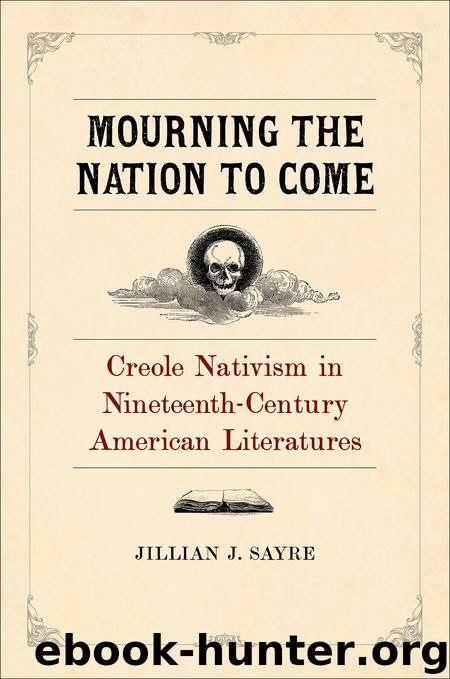Mourning the Nation to Come by Jillian Sayre

Author:Jillian Sayre
Language: eng
Format: epub
Publisher: LSU Press
Published: 2019-06-14T16:00:00+00:00
AnOther Mother
Against this hearty reconciliation of the white, Christian American community lingers the specter of another mother, Hobomok’s mother. This Native American mother has the potential to serve as a third mother figure for Mary, a potential substitution emphasized by the fact that Mary had served as a nurse not only for her own mother and Arabella but for this Native mother as well. It is Hobomok’s mother’s ailing health and Mary’s care for her that instigated the desire of the Indian chief for his future wife. “If something within taught him to copy . . . all the kind attention of the white man,” the narrator says, explaining Hobomok’s devotion to Mary, “’twas gratitude for the life of his mother which she had preserved.”117 It is this mother who celebrates the news of their marriage by dancing, singing, and caressing Mary with “frantic joy,”118 it is this mother who nurses Mary in her deranged state,119 and it is this mother who tends to Mary in her married life. “All the kind attentions which could suggest themselves to the mind of a savage,” the narrator says, “were paid by her Indian mother.”120 Having worked so diligently to demonstrate the conciliatory work of the maternal figure, the mother’s role in the generation of community, the novel here seems to offer an alternative to the dominant structure, one birthed by the Other mother. But, in opposition to the generative acts of the two white mothers, this foundational potential is frustrated by the death of “the old squaw,” a death that is disclosed but never narratively present. After the narrator’s distant and brief description of Mary’s life with Hobomok, spanning two years in two paragraphs and described as a period in which “nothing occurred of any importance to our story” save the brief note that Mary gave birth to a son,121 she/he/I/We declare: “After this general view of things, we must now pass over to . . . 1633, and leave the interim to the reader’s imagination.”122 It is within this span of silence, the narrator says later, that “the old squaw had lately died.” Unlike her white counterparts, this mother gains nothing by death; this other mother shrinks into the shadows much like her son will do. These Native deaths thus demonstrate a melancholic disavowal that takes the form of the “never never,” a refusal of acknowledgment described by Judith Butler in The Psychic Life of Power. This refusal denies both love and loss, saying, “I have never loved and therefore never lost the other.” This silence forecloses the possibility of identification; the haunting Native American described by Renée Bergland might therefore be seen as a product of deep structure, an inability to grieve that girds the subject’s fundamental social identification. This barred identification remains exiled through the ritual practices of mourning. Neither the characters nor the readers return “again and again to [the] defiled grave” of the Native.123 Where is Hobomok or his mother buried after all? How can I return
Download
This site does not store any files on its server. We only index and link to content provided by other sites. Please contact the content providers to delete copyright contents if any and email us, we'll remove relevant links or contents immediately.
| African | Asian |
| Australian & Oceanian | Canadian |
| Caribbean & Latin American | European |
| Jewish | Middle Eastern |
| Russian | United States |
4 3 2 1: A Novel by Paul Auster(12333)
The handmaid's tale by Margaret Atwood(7711)
Giovanni's Room by James Baldwin(7256)
Asking the Right Questions: A Guide to Critical Thinking by M. Neil Browne & Stuart M. Keeley(5712)
Big Magic: Creative Living Beyond Fear by Elizabeth Gilbert(5682)
Ego Is the Enemy by Ryan Holiday(5351)
The Body: A Guide for Occupants by Bill Bryson(5034)
On Writing A Memoir of the Craft by Stephen King(4893)
Ken Follett - World without end by Ken Follett(4688)
Adulting by Kelly Williams Brown(4536)
Bluets by Maggie Nelson(4515)
Eat That Frog! by Brian Tracy(4484)
Guilty Pleasures by Laurell K Hamilton(4395)
The Poetry of Pablo Neruda by Pablo Neruda(4068)
Alive: The Story of the Andes Survivors by Piers Paul Read(3999)
White Noise - A Novel by Don DeLillo(3982)
Fingerprints of the Gods by Graham Hancock(3966)
The Book of Joy by Dalai Lama(3947)
The Bookshop by Penelope Fitzgerald(3812)
